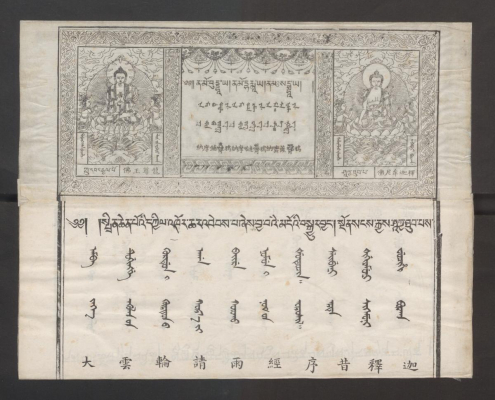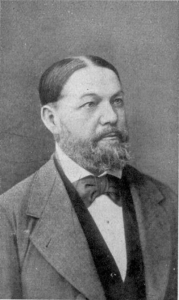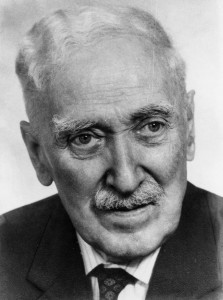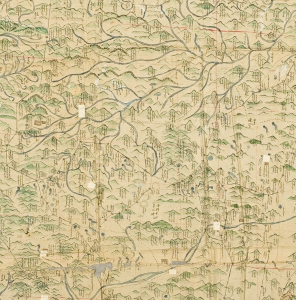Mongolian collection at Staatsbibliothek zu Berlin
The modern collection of the Mongolian holdings at Staatsbibliothek zu Berlin is mainly composed of acquisitions from Mongolia and the Inner Mongolia Autonomous Region. This also includes publications in Mongolian from other parts of the People’s Republic of China (e.g., Beijing). The focus is on the acquisition of original language Mongolian literature. The library collects materials in both the Cyrillic script, which are acquired in Mongolia, as well as the classical Mongolian script, acquired mainly in the Inner Mongolia Autonomous Region. Thematically, it focuses on the social sciences and the humanities, such as religion, history, and literature in different genres, e.g., novel or poetry. The modern, ever-growing collection comprises more than 21,500 titles in February 2021.
History of the Mongolian collection
The pre-modern Mongolian holdings presented below can be searched via the portal “Orient Digital“. There, all manuscripts and block prints in Mongolian preserved in the State Library are listed, with notes on their cataloguing status and, if available, the digital copies.
Wilhelm Schott (1802–1889) acquired the first Mongolian manuscripts for the then Königliche Bibliothek (Royal Library, the predecessor institution of the Staatsbibliothek) in 1863. These are six Kalmyk manuscripts which are still in the holdings of Staatsbibliothek zu Berlin under the shelf marks Ms. or. fol. 1595–1599. Schott had been an associate professor of Asian languages at the Berlin University since 1838, where he had previously written his habilitation on a Sinological topic. This shift in subject from his Oriental studies to East Asian studies was probably due to his work in Halle (Germany) as a tutor for two Chinese. He also worked on the Altaic languages. In 1830, he began cataloguing the Chinese collection at the Berlin library. The resulting catalogue appeared in 1840. The Kalmyk manuscripts he acquired ranged widely in subject matter from Buddhist writings (Ms. or. fol. 1595, 1596, 1598), to a text on historiography (Ms. or. fol. 1597), to a collection of tales of Indo-Tibetan origin (Ms. or. fol. 1599).
During the next decades, the Mongolian collection grew continuously. A wide variety of objects were acquired. With the onset of World War II, the pre-modern holdings were packed and relocated. Some had been taken to areas that, due to the rearrangement of borders after the war, had become Polish territory. There, after the end of the war, the book crates were found and brought centrally into the Biblioteka Jagiellońska in Krakow where they have been kept safe until today.
Further information can be found in the thematic portal on the Berlin-Krakow project. Within the framework of this project, the objects were digitized until 2014 and made accessible online in the Digitised Collections of Staatsbibliothek zu Berlin. There they can be searched with the search key “verlagerte Bestände digital Ostasiatica“. The objects that were relocated to areas of the later Federal Republic of Germany were mainly collected and catalogued in Marburg. After the completion of the new library building at Potsdamer Platz, they were brought back to what had become by then West-Berlin.

Slg Müller 72
After World War II, the special subject collection (Sondersammelgebiet, SSG) was established by means of funding by the German Research Foundation (Deutsche Forschungsgemeinschaft, DFG) in order to give researchers and scholars the opportunity to obtain needed specialized literature and to catch up again with international research. The aim of this collecting activity was to make at least one copy of every relevant work available in Germany. The SSG’s started their work in 1949. Mongolian literature has since been collected in “SSG 6,25 East and Southeast Asia” at Staatsbibliothek zu Berlin. Thematically, the wide range of the humanities and the social sciences were covered. With this financial aid, an extensive collection of Mongolian literature was built up over the next decades. Starting in 2014, there was a profound reorientation effected by the DFG which was marked e.g., by the prioritisation of digital media formats in acquisition. The SSG’s were successively replaced by the “Fachinformationsdienste für die Wissenschaft” (FID, specialist information services). Since 2016, the FID Asien has been set up on the digital platform CrossAsia. Thematically, the collecting activities of current literature have only changed slightly; still, the acquisition is strongest in the humanities and social sciences.
Catalogued Collections

Bernhard Jülg
The Jülg Collection
Bernhard Jülg (1825–1886) studied classical philology in Heidelberg and changed to “oriental languages” (Sanskrit, Japanese, Chinese, Tibetan, Turkish, Armenian) after he moved to Berlin. He intensively studied Kalmyk and translated the Gospel of Matthew into this language. On this basis, he drafted the first Kalmyk grammar (“Initia linguae Calmuccicae”). He also worked on Kalmyk fairy tales, and in 1866, he published an anthology of the fairy tales of Siddhi-Kûr (Märchen des Siddhi-Kûr). Under his guidance, Kalmyk printing types were produced at the Vienna Hof- und Staatsdruckerei in Austria.
Jülg’s collection was purchased a year after his death, in 1887. It contains Mongolian and Kalmyk texts. It was possible to identify 51 shelf marks (-groups) that can be attributed to the Jülg estate. The majority of the objects are written in Mongolian or Kalmyk language. There are also some objects in Tibetan language (Ms. or. fol. 594 I, Libri tibetici 40, Ms. or. fol. 1381–1382). In addition to original manuscripts, there are numerous copies of texts in the collection. Jülg himself produced a large part of them when he sifted and collated the Dresden collection of Kalmyk and Mongolian manuscripts (Ms. or. fol. 1360–1361, Ms. or. fol. 1364–1365, Ms. or. fol. 1367–1370, Ms. or. fol. 1372–1377). His copies of other, unknown sources are: Ms. or. fol. 1353, Ms. or. fol. 1366, Ms. or. fol. 1371, Ms. or. fol. 1378.In addition, he also received copies of miscellaneous texts from various colleagues. These copies partly laid the foundation for his publications. In 1846, for example, Isaac Jacob Schmidt (1779–1847) presented him with a Kalmyk collected manuscript (Ms. or. quart. 765) which was to become the basis for his translation of the tales of the Siddhi-Kûr. Lama Galsang Gomboev (1818–1863) sent him a copy he had made of Arǰi Borǰi texts (Ms. or. quart. 767), which was to become the basis of the Mongolian Tales of 1868. In addition, it is worth mentioning a manuscript with texts of Chinggis Khan poetry (Ms. or. fol. 1355), which came from the possession of Schilling von Canstadt (1786–1837). In terms of content, a broad spectrum is covered, from Buddhist texts to folk tales, which also reflects Jülg’s research interests.

Erich Haenisch
The Haenisch Collection
Erich Haenisch (1880–1966) studied Chinese, Manchurian and Mongolian in Berlin. After completing his dissertation, he lived from 1904 for seven years as a language instructor at the Military Academy in Wuchang. During this time, he travelled to many parts of China. After his return to Germany, he was habilitated and held several professorships in Germany (Berlin, Leipzig, Munich). He travelled to China and Mongolia several more times, for example, in 1928 and 1936 during his last trip to China. During this period, he studied Sino-Manchurian files in Beijing archives. His research interests included Yuan and Qing period China. Another significant achievement in 1937 was his reconstruction of the Mongol wording of the Secret History of the Mongols (Mongγol-un niγuča tobčiyan) from the Chinese transcription.
He sold this Mongolian collection to the library in 1929. These are the shelf marks Libri Mongolici 44–68, 77–79, 81–91, and 93–138. The contents are mainly Buddhist texts.

Hs. or. 100: Karte des Distrikts des Setsen Khan und Khalkha
The Consten Collection
Hermann Consten (1878–1957) spent most of his life traveling. After working for several years in the African colonies of the German Empire between 1900 and 1905, he studied geography, history, Russian and Mongolian at the Lazarev Institute of Oriental Languages in Moscow (from 1905). After only a short period of time, on behalf of his professor Dimitri B. Anučin, he set out in the direction of Mongolia. There, he spent several years traveling. After an intermediate return to Germany where he worked as a private scholar, he tried to travel to Central Asia again in 1929 and was stranded in Beijing. He lived there from 1929 to 1950 and ran a riding school. After his expulsion in 1950, he returned to Germany where he spent the last years of his life.
He acquired his collection, consisting mainly of Mongolian maps, in Beijing by 1946. After his death, they came to Marburg to the West German Library (Westdeutsche Bibliothek) and later to Berlin. The collection contains 182 maps (Hs. or. 11–162, 232–258, 692–693). The maps depict the following areas: Mongolia, Inner Mongolia, and the Mongolian areas in Gansu and Xinjiang. They were produced during the Qing period and can be dated between 1890 and 1920. The maps have been digitized at the library and are freely available. There is a detailed description of the Mongolian Map Collection on the website.
The Consten collection includes three manuscripts (Hs. or. 268, Hs. or. 272 and Hs. or. sim 7264). The first two shelf marks have already been described. They comprise a quadrilingual index of Lamaistic temple names (Manchurian, Mongolian, Tibetan and Chinese), and a divination text.

Walther Heissig
The Heissig Collection
Walther Heissig (1913–2005) was one of the most important Mongolian scholars in his time. After having finished his doctorate, he worked for several years in East Asia. During this time, he collected the objects from his collection that are now stored in the State Library. After a second habilitation in Bonn in 1957, he received a professorship there. In Bonn, he also founded the Central Asian Seminar in 1964 and established the Collaborative Research Centre on Central Asia from 1969–1989. Another achievement was the establishment of the PIAC (Permanent International Altaistic Conference).
The Mongolian collection of Walther Heissig is very extensive. He acquired the majority of it in Beijing between 1943–1945. Among them are the Beijing block prints (Hs. or. 278–300, Hs. or. 703–722), Mongolian maps (Hs. or. 232–258) and a collection of files (Hs. or. 164–231a). The Beijing block prints are thematically varied and include mainly Buddhist texts, as well as administrative literature (e.g., Hs. or. 713, Rules for the inauguration of officials), and medical texts (Hs. or. 714–716). The texts are written in Mongolian, sometimes parallel with Tibetan text (Hs. or. 279, 285, 706, 707, 708, 709). The 68 records from the Heissig Collection are primarily administrative in content. They are, for example, New Year’s congratulatory addresses to the emperor (Hs. or. 168–182), various submissions on topics of succession and transfer of office and the necessary genealogical tables. The objects Hs. or. 3–6 are also from Heissig but were collected by him between 1941–1943 from Kharatsin and Sürüg Mongols. Thematically, these objects are very heterogeneous and contain, for example, a collection of Mongolian songs, riddles and poems, and a Buddhist treatise.
The Bischoff Collection
Friedrich Bischoff (1928–2009), being a sinologist interested in Buddhism, mastered a variety of Asian languages: In addition to Chinese, he also studied Sanskrit, Mongolian, and Tibetan. He studied and wrote his doctoral thesis in Paris. During his doctoral studies, he travelled throughout Asia from 1955–1957. He began by traveling from Moscow to Ulaanbaatar and toured the country from mid-June 1955 to mid-September 1955. Then he travelled to Beijing and spent a year studying at the university in Beijing. After a brief return to Mongolia in order to travel there again and collect more material, he travelled to Hong Kong via Beijing in the fall of 1956. He embarked for Japan and subsequently stayed there for four weeks. Bischoff found his first job after his studies, in Bonn. There, he was commissioned by Heissig to prepare a catalogue and translations of the colophons of the Mongolian Kanjur. Later, he went to Indiana University (Bloomington) to work as Assistant Professor of Tibetan and Chinese. After 17 years, in 1982, he returned to Hamburg as Professor of Chinese and taught there until his retirement. He established the Hamburg Central Asia Program.
Bischoff’s Mongolian collection, now at Staatsbibliothek zu Berlin, is largely the result of acquisitions made during his trip to Asia in 1955–1957. During this time, he purchased some of the identified objects (Hs. or. 296–300; 701–702) kept in Tokyo. These are mainly Buddhist texts. The remaining objects of the Mongolian collection were aquired in Mongolia. For these, the places of Ulaanbaatar (Hs. or. 295–293, 291), Khentij (Hs. or. 292, 290–287) and Arwajkheer (Hs. or. 286) are documented. The objects from Mongolia are generally modern copies of the texts; thematically, they are religious texts.
Sources
Catalogues
::: Heissig, Walther; Voigt, Wolfgang; George, Dieter; Feistel, Hartmut-Ortwin (Hg.) (1961): Mongolische Handschriften, Blockdrucke, Landkarten. Deutsche Morgenländische Gesellschaft. Stuttgart: Steiner (Verzeichnis der orientalischen Handschriften in Deutschland, Abteilung 1. Mongolische Handschriften, 1).
Further readings
::: Bauer, Wolfgang (1967): Erich Haenisch (1880-1966). In: Zeitschrift der Deutschen Morgenländischen Gesellschaft 117 (2), S. 205–210.
::: Götting, Doris (2012): “Etzel”. Forscher, Abenteurer und Agent ; die Lebensgeschichte des Mongoleiforschers Hermann Consten (1878 – 1957). Erstausg., 1. Aufl. Berlin: Schwarz.
::: Ölberg, Hermann M. (1974): Jülg, Bernhard. In: Neue Deutsche Biographie 10, 642 f. Online verfügbar unter https://www.deutsche-biographie.de/pnd117220973.html#ndbcontent.
::: Walravens, Hartmut (Hg.) (2012): Walther Heissig (1913-2005). Mongolist, Zentralasienwissenschaftler, Literaturwissenschaftler und Folklorist ; Leben und Werk ; Würdigungen, Dokumente, Forschungsberichte und Rundfunkprogramme auf Audio-CD. Unter Mitarbeit von Walther Heissig. Wiesbaden: Harrassowitz.
::: Walravens, Hartmut (2009): Friedrich Bischoff in memoriam. In: Monumenta Serica 57 (1), S. 495–532. DOI: 10.1179/mon.2009.57.1.008.
::: Walravens, Hartmut (2000): Wilhelm Schott und die Königliche Bibliothek. In: Peter Jörg Becker und Tilo Brandis (Hg.): Scrinium Berolinense. Tilo Brandis zum 65. Geburtstag. [Berlin], Wiesbaden: Staatsbibliothek zu Berlin, Preußischer Kulturbesitz; Reichert (Beiträge aus der Staatsbibliothek zu Berlin, Preußischer Kulturbesitz, Bd. 10), ,
::: Walravens, Hartmut; Taube, Manfred; Hahn, Michael; Voigt, Wolfgang; George, Dieter; Feistel, Hartmut-Ortwin (1992): August Hermann Francke und die Westhimalaya-Mission der Herrnhuter Brüdergemeine. Eine Bibliographie mit Standortnachweisen der tibetischen Drucke. Stuttgart: Steiner (Verzeichnis der orientalischen Handschriften in Deutschland, Supl.-Bd. 34).
::: Erich Haenisch in memoriam (1880-1966) (1968). In: Oriens Extremus 15 (2), S. 121–122.